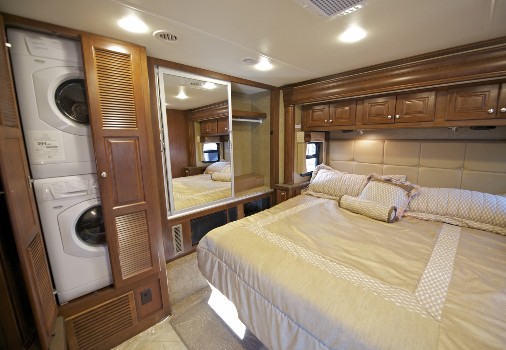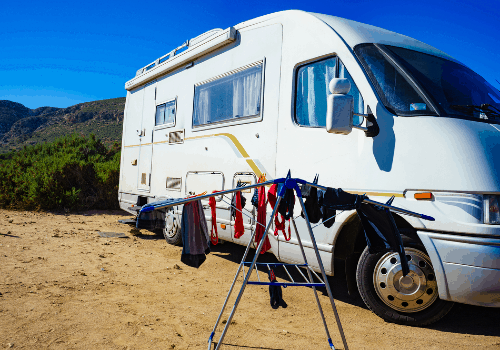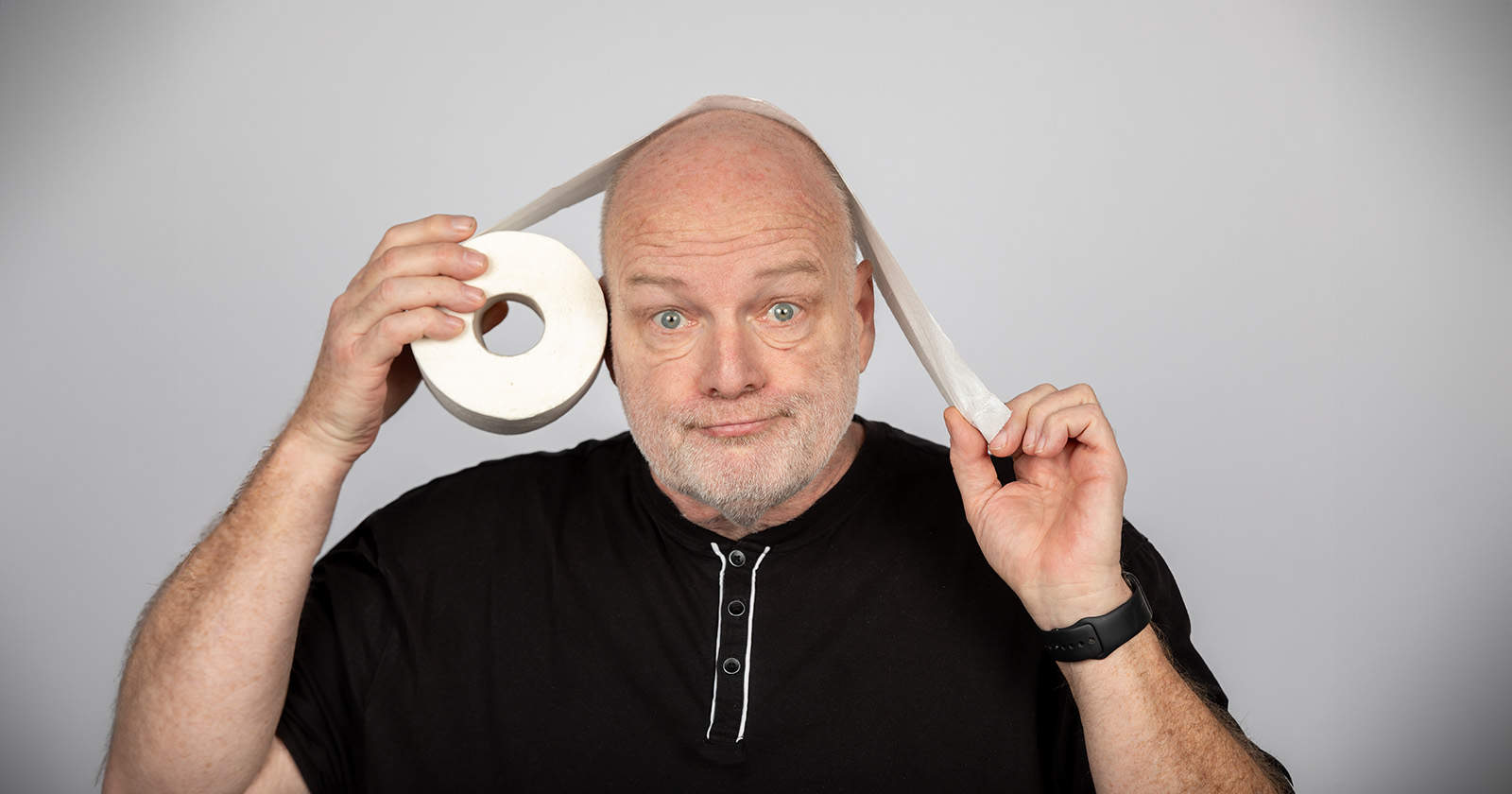A longer RV trip can be one of the best vacations you take. Inevitably, you’re going to have to stop along the way to drain the holding tanks, restock supplies, and fill up your fuel tank. Having an RV washer and dryer with you can keep you on the road without an extra stop.
Why spend valuable driving or camping time hanging out at a coin-operated laundry, when you can use your own? There are many different versions you can choose from that are affordable. When you add up the cost of what you spend at the laundromat, having your own washer/dryer can make your travel budget more comfortable.
In our exploration of washers and dryers for RVs, we’re going to look at the different versions available on the market. Through examples, we’ll show you how RV manufacturers have found creative ways to put them. Finally, we’ll leave you with some shopping tips and other things to be aware of that come with adding a washer/dryer to your coach.
Portable Washer and Dryers

Portable washing machines are small enough to sit on a countertop but big enough to handle between 10- 18 pounds of clothing at one time. You can load socks, t-shirts, and other light garments together in one load. Heavier pieces like jeans and towels can work, but one or two at a time.
The process is pretty simple. Start by loading your clothing and soap. You then fill the basin with water (up to 5 gallons on bigger units). After the washing cycle, the device will drain the water through a connected hose.
Once drained, the washing machine will spin-dry your clothing. This can get your clothes up to 90% dry. To finish drying them, you’ll have to layout or hang your clothing to air dry.
A portable washing machine, like the Giantex Portable Mini Compact Twin Tub, would fit perfectly in your RV’s shower. The washing tub holds 11 pounds of clothing and takes about 15 minutes to go through the timed cycle. The 6.6-pound spinner takes about five minutes to spin your clothes dry.
This washer/dryer machine runs off 110-watt electric power, so plugging it into the bathroom outlet isn’t a problem. To store, the drainage tube attaches to the side, and the power cable wraps up in the back. Once the wash is complete, you’ll want to run a separate rinse cycle to make sure your clothes are free from soap and residual dirt.
Generally, normal dirt and grime should only take one washing cycle. Heavier dirt may need multiple cycles. Depending on the rules of the campground, you could also use the machine outside with your exterior shower.
Dry campers will find these portable devices very handy. They don’t require a lot of electricity and use just a few gallons of water. For those that have smaller RVs, your grey tank may only need one additional draining.
When you hang your clothes to finish drying, your shower’s curtain rod can be used as long as you don’t overweigh it. Some campgrounds have rules preventing guests from hanging clothes outside, so be aware of that. You can also purchase a drying rack that should fit well inside your RV that is inexpensive.
Vented or Ventless Dryers
Dryers come in either vented or ventless versions. The vented types take advantage of the air in the room, using it to dry the clothing. Ventless units use internal heat elements to dry your laundry. Vented washing machines need a vent tube to allow the machine to expel air.
There are pros and cons to consider when you are deciding on a vent or ventless machine. Ventless systems do require longer drying cycles and generally use more water. Many people prefer this version since it’s similar to what they use at home.
Vented machines suck in the air around it to help with the drying process. Using the air and the fast rotation in the dryer removes the moisture from the clothing faster and is more energy-efficient. For those concerned about energy usage, this may be the better way to go.
RV Combo Washer/Dryers
The RV industry has taken advantage of the combination washer and dryer that’s popular in Europe and other countries. These machines wash and dry your clothing in the same basin. They don’t take up a lot of space and can dry your clothing completely.
An excellent example is the Equator 24 inch Combo Washer, Dryer Silver. Its measurements are a few inches shorter than a residential combo model. This machine has won many awards including the RV Pro Magazine’s Best of Show for parts and accessories.
The machine itself is quiet since it runs below 60 decibels. It also has a convertible drying system that allows you to turn it from a ventless to a vented dryer. This can aid in faster drying times.
This combination washer and dryer has a two-minute winterizing cycle. If you’re going to be storing your RV for a while, especially during the winter months, this unit will cycle out residual water from the lines. A best practice is to have the lines filled with RV antifreeze to keep them from drying out.
The unit has multiple settings that are easy to read due to the LED display. You can also set it to delay the washing cycle for up to 24 hours. This way if you’re not ready to run it, you still have time to add more clothes or wait until you are plugged into shore power.
Stackable Washer/Dryer Sets
Stackable washer and dryer units are near residential sizes. Many can handle up to 12 pounds of clothing in each basin. They use more water and have longer cycles. Washers can go between 30- 90 minutes and dryers can last from 45- 180 minutes.
Their advantage is the ability to clean as well as home models. They are also heavy. The RV designers do brace the closets for the extra weight.
Stackable dryers come in either vented or ventless. For those using washer/dryer closets, RV makers have made the closet doors with wooden vents to help with the airflow. If you choose a ventless model, these doors allow the heat buildup from the dryer to dissipate throughout the coach.
Using them while you are driving shouldn’t be a problem. If you rely on your house batteries, know that these washer and dryers are going to require real power. To compensate, using your generator can relieve your batteries.
The Splendide RV Trailer Camper Appliances washer and vented dryer are great examples of an RV stackable set. They don’t require a specialized electric socket. Since this dryer is vented, you will need to create an opening to allow the used air to escape.
The washer has a 15-pound capacity. It comes with 13 pre-programmed cycles and has a 1,200 rpm max spin. Some cycles are designed for wrinkle reduction, light wash, and heavy clothes like jeans.
The dryer is similarly designed to hold the same amount. It uses bi-directional rotation to lessen wrinkling. It has a dry sensor in it to adjust drying time as needed. Both the washer and dryer use 120V.
Common Places Washer and Dryers Fit in RVs
Designers place washer and dryer hookups in many different places. Usually, they create designated closet spaces or put them in bedroom wardrobes. Toy haulers have connections against the back wall of the garage that separates it from the living area.
The space that’s designed for your washer/dryer will have a white plastic square with three connections in it. The red line is your hot water, and the blue is for cold water. There is a black PVC pipe that is used to connect your washer to your grey holding tank.
To determine which type of washer and dryer would be best for your RV, consider the placement. If it’s the size of a shirt closet, then the combo unit is your best choice. Full-length closets can handle the stackable machines.
As washer and dryers gained more appeal, RV manufacturers have found more creative ways to place separated washer and dryers. If you look at the Grand Design Reflection 300RBTS, you’ll see two places that are prepped for a washer and dryer.
Behind the front cap of the travel trailer is a full-length closet with a shelf on the door and off-door side. Based on the plumbing, you’ll see that the off-door side has connections for a washer, and the door side has dryer connections. In this situation, you could choose either a combo washer or pick the separated units.
The Newmar Baystar 3408 is a Class A gas motorhome that has a full closet in the rear of the RV. The closet can hold a stacked washer and dryer set. The design places the closet between a long clothes closet and the built-in wardrobe to make putting your clothes away convenient.
The Baystar series is the shortest in Newmar’s lineup. This 34-foot motorcoach has a lot of storage for its size, but every RVer knows the value of extra space. Using a combo washer/dryer still gives you room to use the upper half of the space for storage.
The Keystone Raptor 351 fifth wheel toy hauler places the washer/dryer prep in the garage. It’s located next to the door that connects the garage to the living area. The wall is big enough to fit a residential side-by-side washer and dryer.
You could use a stackable here, but make sure it’s secure. With various road conditions, the last thing you want is the stackable set falling over. This can damage your washer/dryer as well as the RV itself.
If you have a smaller RV like the Gulf Stream Vintage Cruiser 23RSS, portable machines will fit nicely in the shower. The coach has a pass-through bathroom that separates the shower from the toilet and sink. With storage at such a premium, having the ability to wash your clothes on your trip means using less space for clothing since you can wash them.
Features To Look At When You’re Shopping
We covered many features of the various laundry machines for your RV. When you’re ready to buy your own, here is a list of items you should look into to find the perfect one for you. Choose the things that you believe will fit best for your camping lifestyle.
- Steam Cycle Capability: Washers that have steam cycles increase cleaning potential. The steam relaxes the fibers of the clothing, allowing the water and detergent to eliminate stains and dirt more thoroughly. For those that focus their RV vacation on outdoor activities, this feature can be very appealing.
- Load Capacity: Think about how many people are going to be traveling with you and how often you want to run your laundry. If it’s only two of you, a smaller capacity washer and dryer could be a better way to go. Smaller models can save you money, yet still have many of the same features as the large ones.
- Laundry Strategy: Having laundry get in the way of your vacation fun can feel like it defeats the purpose of going on vacation in the first place. Working out a system of running laundry around your vacation doesn’t have to make it too much of a chore. This strategy can also help you determine what type of washer/dryer to buy.
If you want to throw in a load before you head out for your day’s activities, a combo washer and dryer may work better for you. When you return to your RV, the laundry will have run through both the washing and drying cycle. This allows you to return to dry clean clothes ready to be put away instead of having wet clothes sit in the washer all day.
If you’re visiting many different destinations, running your laundry while your driving is another technique. As long as your RV has the ability, your completing a necessary chore and still enjoying the scenery. When you pull over for fuel or food, you can place another load in for the next leg of your journey.In this scenario, you’ll want to make sure that your freshwater tank has plenty of water available and house batteries are charged. In towables, the house batteries charge when they are plugged into either shore power or solar panels. If you’re doing this on a regular basis, you’ll want to stop for a night or two to replenish the batteries, refill water, and drain the grey tank.
- Washing/Drying Settings: Laundry machines have come a long way with their settings. Many now have pre-programmed cycles for optimum cleaning. Even with the regular settings like water temperature and type of clothing settings, these programs can give the washing cycle an extra boost where it’s needed. Look into the functions that appeal to you.
RVing is a downsized lifestyle where some choose to wear easy to wash clothing. Others may need additional cycles due to the events on their trip. Visiting family members for a holiday gathering or professional entertainers may need a washer and dryer that can take care of specialty outfits.
- Dryer Steam Feature: If wrinkling is a factor for you, some dryers do have a steam feature. The steam can smooth out clothing that is wrinkle-prone. This option can also keep your dryer from odor build-up by using the steam to clean out the basin.
- Motion Sensor in the Dryer: The motion sensor turns the dryer off if the load becomes unbalanced or the machine starts rocking. The jostling from road conditions shouldn’t affect this sensor. It’s used to prevent damaging your clothes and the machine itself.
- Express Drying: When time is not on your side, the express dry function speeds up the drying process. These features either increase the vented air or raise up drying temperatures in ventless versions. To preserve your dryer, don’t use this feature too often.
Last Points For Consideration
Most RVs that are pre-plumbed for washer and dryers don’t come with the machines. Top-end Class A diesel may come with them as part of a package. The RV makers don’t usually include them in order to keep purchase prices down on the coaches themselves.
Combo units can range in price between $1,200- $1,500. Stackable units have price points around $2,500 or more. The competition between appliance manufacturers keeps them introducing new machines all the time. Not everyone living the RV lifestyle wants to lose the storage space.
These concerns and others are why the RV manufacturers don’t include laundry machines from the factory. If you do want one at the time of purchase, your RV dealer may have some models that they sell regularly. There could be better prices on the same products online or through other stores, but having their technicians lift and install them has its benefit.
Installation

Laundry machines are easy to install in your RV. The washing machine’s hot and water lines are labeled by the appliance builder. The drain hose goes down the black PVC pipe on your pre-plumbed hookup.
The only extra step that may appear comes with vented dryers. You’ll have to cut a hole in your RV to allow the exhaust from the dryer out. There are exterior vent cover kits you can buy to prevent water and other things from getting inside.
Before you grab your drill, you always want to make sure you know what’s behind your walls. Steer clear of wires and piping. Your walls are made out of multiple layers that are bonded together. For aesthetics, you’ll want to avoid creating the hole in the middle of your decals or painted accents.
Laundry Soaps
RV washer and dryers can use the same type of laundry detergents you use at home. The filters and various other parts are of the same caliber as home units. If you purchase an HD washing machine, make sure to only use that type of soap since their chemical makeups are different.
Grey Holding Tank
Your RV has three water holding tanks. The freshwater tank, grey holding tank, and the black water tank. Washers that use manufacturer pre-plumbed hookups will empty into your grey tank.
Your grey tank collects wastewater from everything except your toilet. This primarily includes your sink and shower. Using RV washer/dryers, even the portables that drain in your shower can fill up your grey tank faster than you are used too.
Monitor your tank levels daily to see how full they are. If it fills up, the grey tank will back up into your sink and shower. These washers are water-efficient, but after a few loads, you may want to think about draining your tank if it’s been three or four days.
If you aren’t in one spot, there are plenty of places on the road you can find to dump your tank. Travel stops like Pilot/Flying J, Love’s, and TA-Petro are nationwide, and almost all of their locations have RV dump stations. In certain states, major highway rest stops have dump stations.
Websites like Sanidumps.com or RVdumps.com list dump station locations across the country. Many campgrounds will let passersby use their dump stations for a nominal fee. States like South Dakota have dump stations located at local city parks.
One thing we don’t recommend is emptying your tanks outside of a proper disposal station. It’s illegal and harms the environment. The fines can cost you the rest of your vacation.




